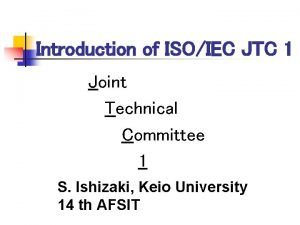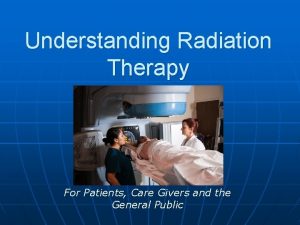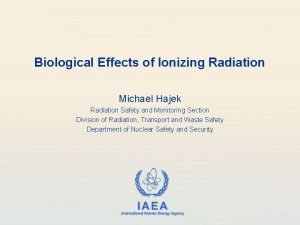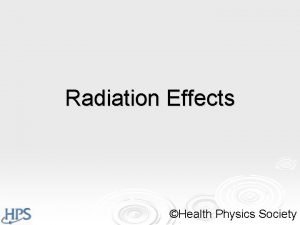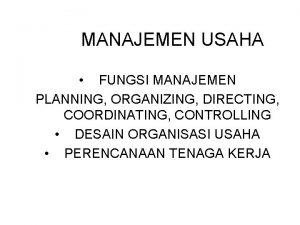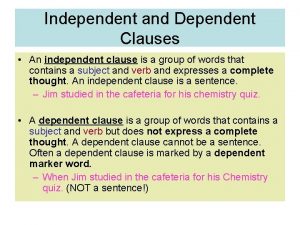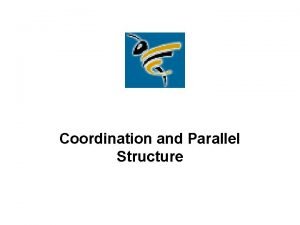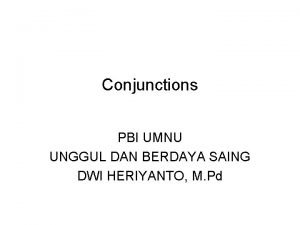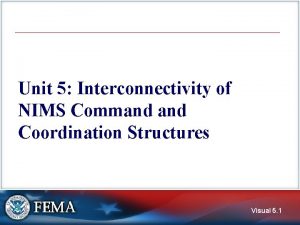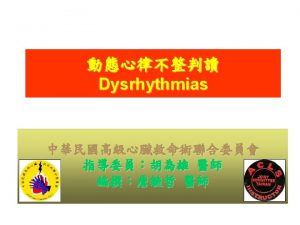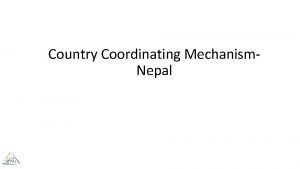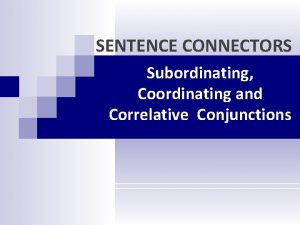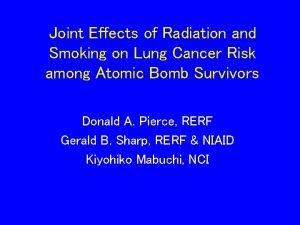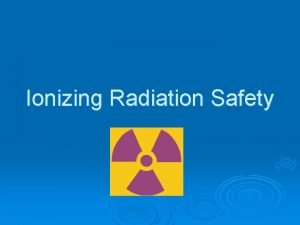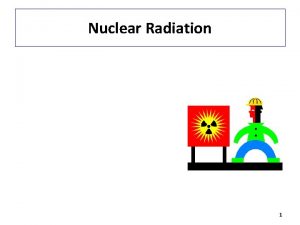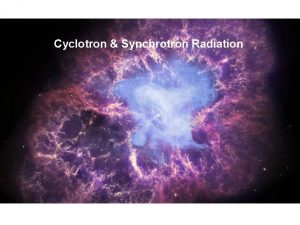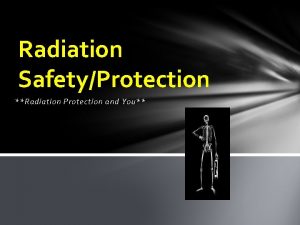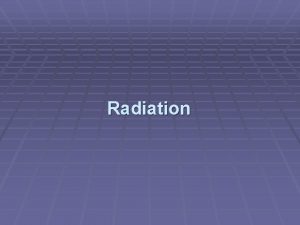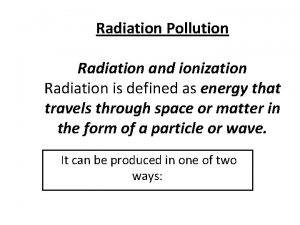Joint Coordinating Committee for Radiation Effects Research Radiation






























- Slides: 30

Joint Coordinating Committee for Radiation Effects Research Radiation Dose Reconstruction for the Techa River and Mayak Worker Cohorts Bruce Napier, Michael Smith; PNNL Marina Degteva; URCRM Alexander Efimov; SUBI Plenary Session #3 │ Monday - October 1, 2018

Brief Historical Background § The Mayak plutonium facility began operating in 1948, in the Southern Urals, Russia. § Worker exposures in the early years were VERY high. § Waste-storage failures resulted in several releases of uranium fission products (90 Sr, 89 Sr, 137 Cs, 95 Zr, 95 Nb, 144 Ce, 106 Ru, 131 I, etc. ) into the environment: − 1949 -1956: 1. 15× 1017 Bq of liquid wastes were released into the Techa River; − 1957: 7. 4× 1016 Bq were accidentally discharged into the atmosphere by a tank explosion which formed the East Urals Radioactive Trace (EURT); − 1967: 2. 2× 1014 Bq were windblown from Lake Karachay (an Plenary Session #3 │ Monday - 2 October 1, 2018 │

Background Location of Mayak Adapted from Bradley, Donald J. Behind the Nuclear Curtain: Radioactive Waste Management in the Former Soviet Union. Battelle Press, Columbus, OH (1997) Plenary Session #3 │ Monday - 3 October 1, 2018 │

View of Mayak Complex Plenary Session #3 │ Monday - 4 October 1, 2018 │

A-reactor: Mayak’s first Plenary Session #3 │ Monday - 5 October 1, 2018 │

Radiochemical Plant Plenary Session #3 │ Monday - 6 October 1, 2018 │

Plutonium Plant Plenary Session #3 │ Monday - 7 October 1, 2018 │

Mayak Workers – External Dosimetry § Based primarily on extensive film badge records 84% workers - Archive Dose 16% workers – Coworker § Exposure Scenarios Source term Exposure Geometry § Transport Calculations Plenary Session #3 │ Monday - 8 October 1, 2018 │

MWDS External Doses are Large, Decrease with Time Plenary Session #3 │ Monday - 9 October 1, 2018 │

Mayak Workers – Internal Dosimetry § 8, 043 workers monitored for intakes via urinalysis § ~1, 240 worker autopsy cases are available; ~500 of these also have earlier urinalysis bioassay § Project 2. 4 used these data to develop rate constants for the lung and systemic biokinetic models Collaborative work with SOLO and U. S. Transuranium and Uranium Registries has demonstrated a bound fraction of inhaled Pu material § Impact of DTPA administration taken into account § Addition of americium component of dose underway § 2 -Dimensional Monte-Carlo Bayesian model used for reconstruction of internal doses – the PANDORA code 10 Plenary Session #3 │ Monday - October 1, 2018 │

MWDS-2016 Doses from Internal Sources Monitored Mayak Worker Cohort of 8043 Workers Organ Median, m. Gy Mean, m. Gy Maximum, m. Gy Bone surface cells 108 707 46, 600 Liver Lung (weighted sum) 27 177 11, 300 31 185 8, 980 § A typical internal dose history −Improved lung model Plenary Session #3 │ Monday - 11 October 1, 2018 │

Job Exposure Matrix § Objective: Take the internal dosimetry information from monitored workers and propagate it to unmonitored workers employed at similar workplaces and periods of time § Use computed plutonium intakes for each monitored worker as the starting data − Select an intake from the distribution of worker intakes − Associated shared parameters will be saved to enable the forward calculation of dose for the unmonitored workers − The output will be dose distributions in a format equivalent to those for monitored workers § Will allow addition of many more workers and worker. Plenary Session #3 │ Monday - 12 years to epidemiological analyses October 1, 2018 │

MWDS-2016 Doses Population Distribution of Weighted Lung Dose, m. Gy Population Distribution of Liver Dose, m. Gy Plenary Session #3 │ Monday - 13 October 1, 2018 │

Releases into the Techa River Chronic Exposure to 30, 000 Individuals Living in Downstream Villages Degteva MO, NB Shagina, MI Vorobiova, LR Anspaugh, BA Napier. REEVALUATION OF WATERBORNE RELEASES OF RADIOACTIVE MATERIALS FROM THE MAYAK PRODUCTION ASSOCIATION INTO THE TECHA RIVER IN 1949 Plenary Session #3 │ Monday - 14 1951. October 1, 2018 │ Health Physics 102(1): 25 - 38.

Features of the Mayak Region Plenary Session #3 │ Monday - 15 October 1, 2018 │

Routes of Radiation Exposure for the Techa River and EURT Cohorts § Internal exposure due to drinking water drawn from the river and consumption of foods contaminated by river water and fallout; § External exposure from the contaminated floodplain soils and fallout. § The Techa River Dosimetry System (TRDS) was created to support epidemiological studies using individual dose estimates. 16 Plenary Session #3 │ Monday - October 1, 2018 │

Techa River Dosimetry System (TRDS) § The TRDS has been developed to provide estimates of internal and external doses for the Techa Riverside villagers. § The reconstruction of internal doses from intake of radionuclides is based primarily on a large number of measurements of radionuclide burden in humans. § The traditional approach of analyzing all steps of the pathway of exposure is only used as a backup when other approaches have been exhausted. § This methodology is rather unique in the 17 Plenary Session #3 │ Monday - October 1, 2018 │

TRDS Includes 6 Sources of Radiation Exposure § § External and internal exposure on the Techa River § External and internal exposure on the EURT area § Medical exposure at the URCRM clinics § Atmospheric iodine pathways Plenary Session #3 │ Monday - 18 October 1, 2018 │

Measurements of 90 Sr in Techa River Residents Dataset Period of Measurement s Number of People* Number of Measurement s Postmortem measurements of 90 Sr in bones 1951 -1989 240 1, 100 In vivo measurements of 90 Sr in front teeth with tooth beta counter (TBC) 1959 -1997 11, 000 23, 000 In vivo measurements of 90 Sr in body with 1974 -1997 12, 200 28, 000 *whole body counter Lived in Techa Riverside settlements at any time 2, 200 in the period 19502009 -present 2, 800 1960 (WBC) Plenary Session #3 │ Monday - 19 October 1, 2018 │

Reference 90 Sr Intake Function Evaluated using tooth beta counter data Tolstykh EI, Degteva MO, Peremyslova LM, Shagina NB, Shishkina EA, Krivoschapov VA, Anspaugh LR, Napier BA. Reconstruction of long-lived radionuclide intakes for Techa riverside residents: Strontium-90. Health Phys 101(1): 28– 47; 2011 Plenary Session #3 │ Monday - 20 October 1, 2018 │

Organ Doses from External Exposure § Derived from dose rate in air on the Techa River banks and in villages – measured and calculated § Individual doses were calculated in accordance with historical records of individuals’ residence histories § Observational data of typical lifestyles for different age groups § Age-dependent conversion factors from air kerma 21 to organ dose Plenary Session #3 │ Monday - October 1, 2018 │

External Dose Rates Were Validated with TL/OSL Measurements Metlino Church Metlino Mill Muslyumovo Mill Plenary Session #3 │ Monday - 22 October 1, 2018 │

External Dose Estimates for Individuals Validated Using EPR and FISH § Expected doses in the upper Techa Riverside residents exceed the detection limits for EPR (100 m. Gy) and FISH (300 m. Gy) § EPR and FISH measurements were corrected for 90 Sr contribution to tooth enamel dose and bone dose Distance FISHEPR§ Cluster/Settlem EPR and FISH-based dose estimates are comparable to Number from the based of FISH of EPR ents release dose, TRDS donors site, km m. Gy 7 23 510± 72 11 547± 17 0 2. Asanovo, Techa-Brod, M Taskino, Gerasimovka 18 -45 13 390± 10 2 24 223± 83 3. Nadyrov Most, Dadyrovo 48 -50 12 480± 10 2 10 569± 25 0 4. Ibragimovo, lseavo, PHT 54 -70 23 130± 75 34 160± 60 1. Metlino Degteva et al. Analysis of EPR and FISH studies of radiation doses in persons who lived in the upper reaches of the Techa River, Radiat Environ Biophys 54: 433– 444 (2015) Plenary Session #3 │ Monday - 23 October 1, 2018 │

I-131 Dose Estimation § Source term from Project 1. 4 § Atmospheric dispersion approximated using 20072011 hourly results Napier BA, PW Eslinger, EI Tolstykh, MI Vorobiova, EE Tokareva, BN Akhramenko, VA Krivoschapov, and MO Degteva. 2016. Calculations of individual doses for Techa River Cohort members exposed to atmospheric radioiodine from Mayak releases. Submitted to Journal of Environmental Radioactivity Plenary Session #3 │ Monday - 22 October 1, 2018 │

I-131 Doses § Calculated with tool developed for JCCRER Project 1. 4 § Annual Cumulative Thyroid Dose − Mean 193 m. Gy − 3% >1 Gy (youngsters near Ozersk) Plenary Session #3 │ Monday - 25 October 1, 2018 │

Mayak and Techa Include Medical Exposures Procedures Book Patient Cards Procedures per Patient as f(t) Medical Exposure Doses Historic Data Current Evaluations Dose per Unit Procedure as f(t) Example: This woman was examined at the URCRM clinics 39 times in 1957 -2001. Plenary Session #3 │ Monday - 26 October 1, 2018 │

Estimation of Uncertainty by the JCCRER Projects § All individual doses are being estimated with uncertainties § Uncertainty estimates: −Consider shared uncertainties −Consider unshared uncertainties −Consider Berkson and Classical error types −Consider individual autocorrelations −Are saved for epi studies as complete correlated cohort files Plenary Session #3 │ Monday - 27 Napier BA, MO Degteva, NB Shagina, and LR Anspaugh. 2013. Uncertainty Analysis for the Techa River October 1, 2018 │

Uncertainty in 30, 000 Techa River Cohort Member Doses Deterministic Estimates Calculated Used TRDS-2016 D 5 Realizations (from 1500) Generated by Stochastic TRDS-MC Plenary Session #3 │ Monday - 28 October 1, 2018 │

JCCRER Doses § Collection of data and development of models and methods is ongoing § Updated calculations have been provided § The methods and results have international impact: Methods • have been addressed in an upcoming US NCRP report on dosimetry for the Million Radiation Worker Study • have been supplemented by substantial efforts from the European Union Results are incorporated in a recent report on low-dose. Plenary Session #3 │ Monday - 29 October 1, 2018 │

Points for Now and Later For now § These are some of the best cohorts since the Life Span Study; with protracted internal and external exposure § Both Techa and Mayak cohorts are low-dose RATE § Techa can be considered to be largely a low-dose group (although most of the ‘information’ comes from the higher doses) § There are uncertainties, but they are not insurmountable For later § Effects per unit dose internal and external appear to be the same: − this validates the ICRP Effective Dose paradigm − It impacts discussions of DDREF § Epidemiology will never resolve issues in the >1 m. Sv 30 range, but LNT is a good operational tool Plenary Session #3 │ Monday - October 1, 2018 │
 Trade promotion coordinating committee
Trade promotion coordinating committee Joint technical committee 1
Joint technical committee 1 Joint information environment
Joint information environment Radiation therapy side effects
Radiation therapy side effects Michael hajek
Michael hajek Radiation effects on chromosomes
Radiation effects on chromosomes Quality grade of lamb
Quality grade of lamb Uncovertebral joint
Uncovertebral joint Permanent joints examples
Permanent joints examples Memorandum joint venture account is
Memorandum joint venture account is Lamb grading chart
Lamb grading chart Plane joint
Plane joint Presidential infrastructure coordinating commission
Presidential infrastructure coordinating commission Presidential infrastructure coordinating commission
Presidential infrastructure coordinating commission Directing planning organizing controlling
Directing planning organizing controlling Abbi saw a wuwu words
Abbi saw a wuwu words Dependant clause definition
Dependant clause definition Fanboys and swabi
Fanboys and swabi Examples of subordinating conjunctions
Examples of subordinating conjunctions Coordinating conjunction quiz
Coordinating conjunction quiz Coordinating european council
Coordinating european council Marketing strategy formation process
Marketing strategy formation process Parallel structure with correlative conjunctions
Parallel structure with correlative conjunctions Conjunction slides
Conjunction slides Seven coordinating conjunctions
Seven coordinating conjunctions What is your function
What is your function The central instrument for directing and coordinating
The central instrument for directing and coordinating Posdcorb examples
Posdcorb examples Organizing staffing directing controlling
Organizing staffing directing controlling The marketing plan the central instrument
The marketing plan the central instrument Which nims command and coordination
Which nims command and coordination

